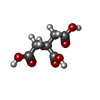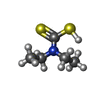[English] 日本語
 Yorodumi
Yorodumi- PDB-4olc: Carbamate kinase from Giardia lamblia thiocarbamoylated by disulf... -
+ Open data
Open data
- Basic information
Basic information
| Entry | Database: PDB / ID: 4olc | ||||||
|---|---|---|---|---|---|---|---|
| Title | Carbamate kinase from Giardia lamblia thiocarbamoylated by disulfiram on Cys242 | ||||||
 Components Components | Carbamate kinase | ||||||
 Keywords Keywords | TRANSFERASE / ADP / Mg2+ / carbamate / carbamoyl phosphate | ||||||
| Function / homology |  Function and homology information Function and homology information | ||||||
| Biological species |  | ||||||
| Method |  X-RAY DIFFRACTION / X-RAY DIFFRACTION /  SYNCHROTRON / SYNCHROTRON /  MOLECULAR REPLACEMENT / Resolution: 2.6 Å MOLECULAR REPLACEMENT / Resolution: 2.6 Å | ||||||
 Authors Authors | Lim, K. / Herzberg, O. | ||||||
 Citation Citation |  Journal: J.Biol.Chem. / Year: 2014 Journal: J.Biol.Chem. / Year: 2014Title: Structural Basis for Inactivation of Giardia lamblia Carbamate Kinase by Disulfiram. Authors: Galkin, A. / Kulakova, L. / Lim, K. / Chen, C.Z. / Zheng, W. / Turko, I.V. / Herzberg, O. #1:  Journal: Acta Crystallogr.,Sect.F / Year: 2010 Journal: Acta Crystallogr.,Sect.F / Year: 2010Title: X-ray structure and characterization of carbamate kinase from the human parasite Giardia lamblia. Authors: Galkin, A. / Kulakova, L. / Wu, R. / Nash, T.E. / Dunaway-Mariano, D. / Herzberg, O. #2:  Journal: Plos One / Year: 2013 Journal: Plos One / Year: 2013Title: Crystal structures of carbamate kinase from Giardia lamblia bound with citric acid and AMP-PNP. Authors: Lim, K. / Kulakova, L. / Galkin, A. / Herzberg, O. | ||||||
| History |
|
- Structure visualization
Structure visualization
| Structure viewer | Molecule:  Molmil Molmil Jmol/JSmol Jmol/JSmol |
|---|
- Downloads & links
Downloads & links
- Download
Download
| PDBx/mmCIF format |  4olc.cif.gz 4olc.cif.gz | 240.2 KB | Display |  PDBx/mmCIF format PDBx/mmCIF format |
|---|---|---|---|---|
| PDB format |  pdb4olc.ent.gz pdb4olc.ent.gz | 194.9 KB | Display |  PDB format PDB format |
| PDBx/mmJSON format |  4olc.json.gz 4olc.json.gz | Tree view |  PDBx/mmJSON format PDBx/mmJSON format | |
| Others |  Other downloads Other downloads |
-Validation report
| Summary document |  4olc_validation.pdf.gz 4olc_validation.pdf.gz | 499.8 KB | Display |  wwPDB validaton report wwPDB validaton report |
|---|---|---|---|---|
| Full document |  4olc_full_validation.pdf.gz 4olc_full_validation.pdf.gz | 539.4 KB | Display | |
| Data in XML |  4olc_validation.xml.gz 4olc_validation.xml.gz | 50.7 KB | Display | |
| Data in CIF |  4olc_validation.cif.gz 4olc_validation.cif.gz | 68.4 KB | Display | |
| Arichive directory |  https://data.pdbj.org/pub/pdb/validation_reports/ol/4olc https://data.pdbj.org/pub/pdb/validation_reports/ol/4olc ftp://data.pdbj.org/pub/pdb/validation_reports/ol/4olc ftp://data.pdbj.org/pub/pdb/validation_reports/ol/4olc | HTTPS FTP |
-Related structure data
| Related structure data | 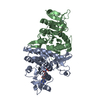 4jz7S S: Starting model for refinement |
|---|---|
| Similar structure data |
- Links
Links
- Assembly
Assembly
| Deposited unit | 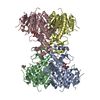
| ||||||||
|---|---|---|---|---|---|---|---|---|---|
| 1 | 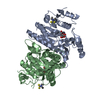
| ||||||||
| 2 | 
| ||||||||
| Unit cell |
|
- Components
Components
| #1: Protein | Mass: 33975.219 Da / Num. of mol.: 4 Source method: isolated from a genetically manipulated source Source: (gene. exp.)   #2: Chemical | ChemComp-CIT / #3: Chemical | #4: Water | ChemComp-HOH / | Has protein modification | Y | |
|---|
-Experimental details
-Experiment
| Experiment | Method:  X-RAY DIFFRACTION / Number of used crystals: 1 X-RAY DIFFRACTION / Number of used crystals: 1 |
|---|
- Sample preparation
Sample preparation
| Crystal | Density Matthews: 2.49 Å3/Da / Density % sol: 50.51 % |
|---|---|
| Crystal grow | Temperature: 295 K / Method: vapor diffusion, hanging drop / pH: 5 Details: 0.4 M ammonium citrate dibasic, 21% PEG3350, crystal soaked in 2 mM disulfiram overnight, pH 5.0, VAPOR DIFFUSION, HANGING DROP, temperature 295K |
-Data collection
| Diffraction | Mean temperature: 100 K |
|---|---|
| Diffraction source | Source:  SYNCHROTRON / Site: SYNCHROTRON / Site:  APS APS  / Beamline: 23-ID-B / Wavelength: 1.0332 Å / Beamline: 23-ID-B / Wavelength: 1.0332 Å |
| Detector | Type: MARMOSAIC 300 mm CCD / Detector: CCD / Date: Jun 8, 2011 / Details: mirrors |
| Radiation | Monochromator: Double crystal cryo-cooled Si(111) / Protocol: SINGLE WAVELENGTH / Monochromatic (M) / Laue (L): M / Scattering type: x-ray |
| Radiation wavelength | Wavelength: 1.0332 Å / Relative weight: 1 |
| Reflection | Resolution: 2.6→49 Å / Num. all: 40662 / Num. obs: 40662 / % possible obs: 99.1 % / Observed criterion σ(F): 0 / Observed criterion σ(I): 0 / Redundancy: 3.4 % / Biso Wilson estimate: 34 Å2 / Rmerge(I) obs: 0.082 / Net I/σ(I): 10.8 |
| Reflection shell | Resolution: 2.6→2.71 Å / Redundancy: 3.4 % / Rmerge(I) obs: 0.314 / Mean I/σ(I) obs: 3.8 / Num. unique all: 4635 / % possible all: 99.7 |
- Processing
Processing
| Software |
| ||||||||||||||||||||
|---|---|---|---|---|---|---|---|---|---|---|---|---|---|---|---|---|---|---|---|---|---|
| Refinement | Method to determine structure:  MOLECULAR REPLACEMENT MOLECULAR REPLACEMENTStarting model: PDB ENTRY 4JZ7 Resolution: 2.6→49 Å / Isotropic thermal model: ISOTROPIC / Cross valid method: THROUGHOUT / σ(F): 0 / Stereochemistry target values: Engh & Huber
| ||||||||||||||||||||
| Displacement parameters | Biso mean: 43 Å2 | ||||||||||||||||||||
| Refinement step | Cycle: LAST / Resolution: 2.6→49 Å
| ||||||||||||||||||||
| Refine LS restraints |
| ||||||||||||||||||||
| LS refinement shell | Resolution: 2.6→2.71 Å
|
 Movie
Movie Controller
Controller


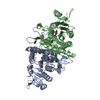
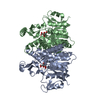
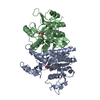
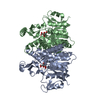
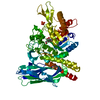


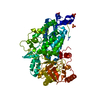
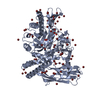
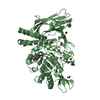

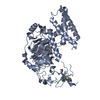

 PDBj
PDBj